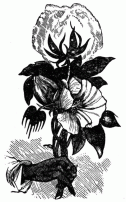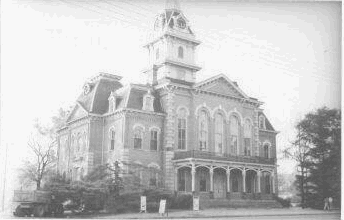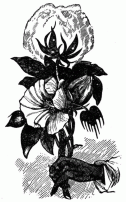


Hancock
County Courthouse
HISTORY
Educators, clergymen, senators, representatives
governors,doctors, authors and planters
sprung forth from the soil of Hancock.
CREATION
-
An Act to lay out a county out of a part of
the counties of Washington and Greene
-
Be it enacted by the Senate and House of Representatives
of the State of Georgia in General Assembly met, and by the authority of
the same,
-
That a new county shall be laid off out of a
part of the counties of Washington and Greene, in the following manner:
A line shall be run beginning near Alexanderís Mill on the north fork of
the Ogeechee, to run in a direct course to Fosterís plantation on the Oconee
river; Thence down the same to the mouth of Buck Creek, near the Rock landing;
thence a direct line to where the lower trading road crosses Town Creek,
from thence with a road leading from the Rock landing to George town, to
where the same crosses the river Ogeechee; thence up Ogeechee to the beginning,
and all that part of the counties of Washington and Greene comprehended
within, and lying between the said lines and boundaries shall be a county,
and known by the name of the county of Hancock; and Hermon Reynolds, Mathew
Rabon, James Adams, Abraham Miles, and John Mitchell, shall be and they
are hereby appointed commissioners, and they or a majority of them, are
veiled with full power and authority to fix on the most convenient and
centr5al place within said county, at which courts and elects shall be
held, as soon as suitable buildings are erected thereat (sic). And
the said commissioners, or a majority of them, are hereby authorized and
empowered to contract with fit and proper persons for the purpose of building
a courthouse and gaol in the county aforesaid; which after at least thirty
days notice, shall be let to the lowest bidder.
-
Provided: That until the courthouse shall
be erected, the courts shall be held at the house of John W. Whatley.
-
And be it further enacted by the authority aforesaid:
That the justices of the inferior court of the said county are hereby authorized
and empowered to levy a tax on the inhabitants, and taxable property, within
the same, for the purpose of erecting a courthouse and gaol in the county
aforesaid; which shall be done in such a manner as ion the judgment of
the court shall be least burdensome to the inhabitants.
-
And be it further enacted by the authority aforesaid,
That Henry Graybill shall be, and is hereby appointed to run the upper
and lower lines bounding the said county; and that the charges thereof
shall be paid by the inferior court of the said county, to be levied, as
in this act directed.
-
IV. And be it further enacted by the authority
aforesaid, That all civil and military officers within the boundaries
of the said county, shall be, and they are hereby confirmed in their commissions.
-
William Gibbons - Speaker
of the House of Representative
-
Benjamin Taliaferro
- President of the Senate
-
George Mathews - Governor
-
December 17, 1793
-
The History of Hancock County,
Georgia by Elizabeth Wiley Smith. 2 volumes. Wilkes Publishing Company,
Inc. Washington, GA, Jan 1974. Page ix.. Submitted by Mary Ann Willoughby
FIRST SETTLERS
-
Among the first settlers of the county were
General H. Mitchell, Bolling Hall, Charles Abercrombie, Henry Graybill,
Joseph Bryan, William Rees, Jonathan Adams, John Montgomery, Jacob Dennis,
Archibald Smith, T. Holt, Thos.Raines, James Bishop, Isham Rees, M. Martin.
R. Clarke, R. Shipp, F. Tucker, L. Barnes, W. Wyley, Wm. Saunders, James
Thomas, Jesse Pope, Jonas Shivers, Wm. Hardy, L. Tatum, R. Moreland. Historical
collections of Georgia. George White. 1854, c1853
1850
-
Extract from the Census of 1850. Dwellings,
761; families, 785; white males, 2,134; white females, 2,078; free coloured
males, 33; free colured females 27. Total free population, 4,272; slaves,
7,306. Deaths, 128. Farms, 444; manufacturing establishments, 20. Value
of real estate, $1,640,646; value of personal estate, $4,049,156. Source:
White's Historical Collections of Georgia 1854
-
1853
-
Hancock county, Ga. Situate E. centrally, and
contains 451 sq. m. Drained by brances of Ogeechee r., its E. boundary,
and of Oconee r., its NW boundary. Surface diversified, with some moderate
hills; soil very productive. This is in the great cotton belt of Georgia,
and attention is directed mainly to its cultivation. Farms 444; manuf.
20; dwell, 761, and pop. wh. 4,212, fr. col. 60, sl. 7,806 - total 11,073.
Capital Sparta.
-
Source: A new and complete statistical
gazetteer of the United States of America, founded on and compiled from
official federal and state returns, and the seventh national census. By
Richard S. Fisher.
-
Fisher, Richard Swainson. comp.
960 p. 25 cm. New York, J. H. Colton, 1853.
1854
-
HANCOCK Definition: a county in
the N. E. central part of Georgia, has an area of 440 square miles. The
Oconee river forms its boundary on the W., the N. fork of the Ogeechee
on the N. E., and it is also drained by Buffalo creek. The surface is diversified,
the dividing ridge between the primary and tertiary formations passing
through the county. The soil in the N. is clayey; in the S. it is sandy,
and covered with a growth of pine. Cotton, Indian corn, and wheat are the
staples. In 1850 this county produced 11,374 bales of cotton; 440,699 bushels
of corn; 72,875 of oats, and 119,205 of sweet potatoes. There were 2 cotton
factories, 7 flour mills, and 8 saw mills. It contained 21 churches, and
339 pupils attending academies and other schools. The county contains an
abundance of granite, and a great variety of rare minerals and precious
stones, including gold, agate, chalcedony, opal, kaolin, zircon, and galena.
(White's Statistics.) The rivers furnish motive-power. Formed in 1793.
Capital, Sparta. Population, 11,578, of whom 4272 were free, and 7306,
slaves. 1854 Gazette
-
Hancock Manufacturing Company-
situated at Sparta; dimensions of factory, 54x140; engine-room, 25 by 54;
eninge, 100 horsepower, capital, $80,000; spindles, 4,500; looms, 100;
operatives, 140; yards of cloth made per day, 3,500; pounds of threat per
day, 500; osnaburgs, sheets &c., are manufactured. Historical
collections of Georgia. George White. 1854, c1853
-
The lovers of natural science
will find much to interest them in this section of the State. Minerals
are abundant, viz., agate, jasper, chalcedony, iron, gold, asbestos, kaolin,
galena, zircon, plubago, epitdote,&c.
-
There are some remarkable
mounds in this county. A gentleman has furnished us with an account of
several on Shoulder Bone Creek. He says. "the principal one is 400 feet
N. of the centre prong of Shoulder Bone Creek; its base is 20 feet above
the level of the creek. A few years ago it was 37 feet high; around it
are the remains of a ditch or intrenchment, containing about four acres.
Near the mound is an inclosure. Human bones, to a large amount, have been
exhumed."
-
Shoulder Bone
Creek is memorable as being the place where a tready was made with the
Creeks in 1786.
-
Historical
collections of Georgia. George White. 1854, c1853
-
1855
-
Hancock County, Ga. Situated a little N.E. of
the centre of the state. Area 431 sq. ms. The Oconee r. runs on its W.
border & Great Ogeechee r. on its E. border. Watered by branches
of these rivers. Capital, Sparta. There were in 1850, live stock valued
at $394,883; Ind. corn, 440,699 bush. produced; sweet potatoes 119,205;
cotton, 11,374 bales; 7 flouring & grist m, 8 saw m.; 2 cotton fac.:
1 tannery, 3 persons employed; Cap. emp. in maufact. $126,185; value of
manufactured articles, $76,064; -2 libraries, 450 vols; 21 churches; 6
academies, 132 pupils; 8 schools, 207 scholars. Pop. 1840 9,652. Pop. 1850
11,578.
-
Source: Harper's statistical gazetteer
of the world / by J. Calvin Smith ; Illustrated by seven maps.
-
vi, 1952 p. New York, Harper &
Brothers, 1855.
1859
-
1859 Hancock County Post Offices
-
Devereaux' Store
-
Long's Bridge
-
Mount Zion
-
Powelton
-
Rock Mills
-
Shoals of Ogechee
-
Sparta (c.h.)
-
List of post offices in the United States ...
United States. Post Office Dept. v. 17-28 cm. Washington, 1859.
1870
-
Hancock--Population, in 1870, 11,317--3,645
white, 7,672 black; 56 per cent. of tillable land cleared; 80 per cent.
of farm laborers black; 34 free public schools for whites, 15 for blacks;
Baptist churches 9, Methodist 13, Presbyterian 2, Episcopal 1, Roman Catholic
1; 1 cotton mill, but now suspended; 1 sash and blind factory; several
cotton-gin and carriage factories.
-
Sparta, the capital town, is situated
on the Macon & Augusta Railroad, 50 miles from Macon and 70 from Augusta,
the market town, though much cotton sold at the place; white population
570, black 250, private dwellings 70, hotels 2, banks 1, churches 4, schools
2, pupils 80, 1 weekly newspaper, 13 dry goods stores, 5 grocery stores,
2 drug stores, 7 physicians, 10 lawyers, 2 dentists.
-
A manual of Georgia for the use of immigrants
and capitalists / prepared under the direction of Thomas P. Janes, commissioner
of agriculture Georgia. Dept. of Agriculture; Janes, Thomas P. :
ii, 119 p. ; 21 cm. Atlanta: [s.n.], 1878
Finister-Walker
German Colony -1907
LINKS
Hancock
County
Hancock
County Courthouse
Historical
markers
National
Register of Historic Places
-
Camilla-Zack Community Center District, Mayfield
-
Cheely-Coleman House
-
Glen Mary Plantation, Linton Road
-
Hurt-Rives Plantation
-
Jackson, John S., Plantation House and Outbuildings,
off Hwy. 16, White Plains
-
Jewell Historic District, GA 248 and GA 16,
Jewell
-
Linton Historic District
-
Pearson, Stephen Edward, House, Deveraux
-
Pearson--Boyer Plantation, Devereaux
-
Rockby, N.E. Sparta, off Hwy 16
-
Shivers-Simpson House, Rock Mill, N of Jewell
on Mayfield Rd., Jewell
-
Shoulderbone Mounds
-
Sparta Cemetery, N of jct. of Hamilton and Boland
Sts., Sparta
-
Sparta Historic District, roughly bounded by
Hamilton, Elm, W, and Burwell Sts., Sparta
Old
Eagle Tavern
Rockby
School for Boys
Sparta
The
New Georgia Encylopedia
Vanishing
Georgia
Digital
Library of Georgia
Sanborn
Fire Insurance Maps of Sparta 1884, 1889, 1895, 1901, 1909, 1920
Eileen B.McAdams copyright 2004

